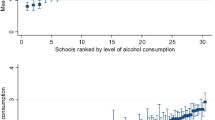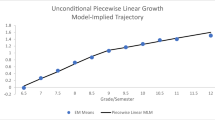Abstract
This paper examines the effect of a student’s own school adjustment as well as the contextual level of school adjustment (the normative level of school adjustment among students in a school) on students’ self-reported use of alcohol. Using a dataset of 43,465 male and female 8th grade students from 349 schools across the contiguous United States who participated in a national study of substance use in rural communities between 1996 and 2000, multilevel latent covariate models were utilized to disentangle the individual-level and contextual effects of three school adjustment variables (i.e., school bonding, behavior at school, and friend’s school bonding) on alcohol use. All three school adjustment factors were significant predictors of alcohol use both within and between schools. Furthermore, this study demonstrated a strong contextual effect: Students who attended schools where the overall level of school adjustment was higher reported lower levels of alcohol use even after taking their own school adjustment into account. The results demonstrate the importance of both a student’s own level of school adjustment and the normative level of school adjustment among students in the school on an adolescent’s use of alcohol. Differences in school adjustment across schools were quite strongly related to an adolescent’s own alcohol use, indicating that school adjustment is an important aspect of school climate. Initiatives aimed at improving school climate may have beneficial effects on students’ alcohol use.


Similar content being viewed by others
Notes
The CDAS is a variation of the American Drug & Alcohol Survey (Oetting et al. 1984) and the Prevention Planning Survey (Oetting et al. 1996), which are the copyrighted property of Rocky Mountain Behavioral Science Institute, Inc. (“RMBSI”), a corporation located in Fort Collins, Colorado. This research project was granted permission to use and modify the survey through a special agreement between RMBSI and the Tri-Ethnic Center for Prevention Research. Others wishing to use this survey or any other copyrighted instruments of RMBSI should contact RMBSI at 1-800-447-6354 or http://www.rmbsi.com.
References
Anderman, E. M. (2002). School effects on psychological outcomes during adolescence. Journal of Educational Psychology, 94, 795–809. doi:10.1037/0022-0663.94.4.795.
Anonymous. (2004). Wingspread declaration on school connections. The Journal of School Health, 74, 233–234. http://www.umass.edu/schoolcounseling/NLC/page3/page20/assets/Wingspread%20Declaration%20on%20School%20Connections.pdf.
Bandura, A. (1977). Social learning theory. Oxford, England: Prentice-Hall.
Battistich, V., & Hom, A. (1997). The relationship between students’ sense of their school as a community and their involvement in problem behaviors. American Journal of Public Health, 87, 1997–2001.
Catalano, R. F., & Hawkins, J. D. (1996). The social development model: A theory of antisocial behavior. In J. D. Hawkins (Ed.), Delinquency and crime: Current theories (pp. 149–197). New York: Cambridge University Press.
Catalano, R. F., Haggerty, K. P., Oesterle, S., Fleming, C. B., & Hawkins, J. D. (2004). The importance of bonding to school for healthy development: Findings from the Social Development Research Group. The Journal of School Health, 74, 252–261.
Cleveland, H. H., & Wiebe, R. P. (2003). The moderation of adolescent-to-peer similarity in tobacco and alcohol use by school levels of substance use. Child Development, 74, 279–291. doi:10.1111/1467-8624.00535.
Eccles, J. S., Early, D., Frasier, K., Belansky, E., & McCarthy, K. (1997). The relation of connection, regulation, and support for autonomy to adolescents’ functioning. Journal of Adolescent Research, 12, 263–286. doi:10.1177/0743554897122007.
Eitle, D. J., & Eitle, T. M. (2004). School and county characteristics as predictors of school rates of drug, alcohol, and tobacco offenses. Journal of Health and Social Behavior, 45, 408–421.
Elliott, D. S., Ageton, S. S., & Canter, R. J. (1979). Integrated theoretical perspective on delinquent behavior. Journal of Research in Crime and Delinquency, 16, 3–27. doi:10.1177/002242787901600102.
Elliott, D. D., Huizinga, D. H., & Ageton, S. S. (1985). Explaining delinquency and drug use. Newbury Park, CA: Sage.
Fleming, C. B., Catalano, R. F., Oxford, M. L., & Harachi, T. W. (2002). A test of generalizability of the social development model across gender and income groups with longitudinal data from the elementary school developmental period. Journal of Quantitative Criminology, 18, 423–439. doi:10.1023/A:1021173711746.
Frankowski, B., Gereige, R., Grant, L., Hyman, D., Magalnick, H., Mears, C. J., et al. (2007). The role of schools in combating illicit substance abuse. Pediatrics, 120, 1379–1384. doi:10.1542/peds.2007-2905.
Goodenow, C., & Espin, O. M. (1993). Identity choices in immigrant adolescent females. Adolescence, 28, 173–184.
Gottfredson, D. C. (1986). An empirical test of school-based environmental and individual interventions to reduce the risk of delinquent behavior. Criminology, 24(4), 705–731. doi:10.1111/j.1745-9125.1986.tb01508.x.
Hawkins, J. D., & Weis, J. G. (1985). The social development model: An integrated approach to delinquency prevention. The Journal of Primary Prevention, 6, 73–97. doi:10.1007/BF01325432.
Hawkins, J. D., Catalano, R. F., & Miller, J. Y. (1992). Risk and protective factors for alcohol and other drug problems in adolescence and early adulthood: Implications for substance-abuse prevention. Psychological Bulletin, 112, 64–105. doi:10.1037/0033-2909.112.1.64.
Hawkins, J. D., Guo, J., Hill, K. G., Battin-Pearson, S., & Abbott, R. D. (2001). Long-term effects of the Seattle social development intervention on school bonding trajectories. Applied Developmental Science, 5, 225–236. doi:10.1207/S1532480XADS0504_04.
Henry, K. L., & Slater, M. D. (2007). The contextual effect of school attachment on young adolescents’ alcohol use. The Journal of School Health, 77, 67–74. doi:10.1111/j.1746-1561.2007.00169.x.
Hirschi, T. (1971). Causes of delinquency. Oxford, England: University of California Press.
Kim, J., & McCarthy, W. J. (2006). School-level contextual influences on smoking and drinking among Asian and Pacific Islander adolescents. Drug and Alcohol Dependence, 84, 56–68. doi:10.1016/j.drugalcdep.2005.12.004.
Ladd, G. W. (1989). Children’s social competence and social supports: Precursors of early school adjustement? In G. Schneider, A. J. Nadel, & R. Weissberg (Eds.), Social competence in developmental perspective (pp. 277–292). Amsterdam: Kluwer.
Ladd, G. W. (1996). Shifting ecologies during the 5 to 7 year period: Predicting children’s adjustment during the transition to grade school. In A. Sameroff & M. Haith (Eds.), The five to seven year shift (pp. 363–386). Chicago: University of Chicago Press.
Libbey, H. P. (2004). Measuring student relationships to school: attachment, bonding, connectedness, and engagement. The Journal of School Health, 74, 274–283.
Ludtke, O., Marsh, H. W., Robitzch, A., Trautwein, U., Asparouhov, T., & Muthen, B. (2008). The multilevel latent covariate model: A new, more reliable approach to group-level effects in contextual studies. Psychological Methods, 13(3), 203–229.
Maddox, S. J., & Prinz, R. J. (2003). School bonding in children and adolescents: Conceptualization, assessment, and associated variables. Clinical Child and Family Psychology Review, 6, 31–49. doi:10.1023/A:1022214022478.
Maes, L., & Lievens, J. (2003). Can the school make a difference? A multilevel analysis of adolescent risk and health behaviour. Social Science & Medicine, 56, 517–529. doi:10.1016/S0277-9536(02)00052-7.
Matsueda, R. L. (1988). The current state of differential association theory. Crime and Delinquency, 34, 277–306. doi:10.1177/0011128788034003005.
McBride, C. M., Curry, S. J., Cheadle, A., Anderman, C., Wagner, E. H., Diehr, P., et al. (1995). School-level application of a social bonding model to adolescent risk-taking behavior. The Journal of School Health, 65, 63–68.
Muthen, L. M., & Muthen, B. O. (1998-2008). Mplus user’s guide (5th ed.). Los Angeles, CA: Authors.
Oetting, E. R., & Beauvais, F. (1987). Peer cluster theory, socialization characteristics, and adolescent drug use: A path analysis. Journal of Counseling Psychology, 34, 205–213. doi:10.1037/0022-0167.34.2.205.
Oetting, E. R., & Beauvais, F. (1990). Orthogonal cultural identification theory: The cultural identification of minority adolescents. The International Journal of the Addictions, 25, 655–685.
Oetting, E. R., Beauvais, F., & Edwards, R. (1984). The American drug and alcohol survey. Rocky Mountain Behavioral Science Institute, Inc.
Oetting, E. R., & Donnermeyer, J. F. (1998). Primary socialization theory: The etiology of drug use and deviance I. Substance Use & Misuse, 33, 995–1026.
Oetting, E. R., Edwards, R., & Beauvais, F. (1996). The prevention planning survey. Rocky Mountain Behavioral Science Institute, Inc.
Osgood, D. W., & Anderson, A. L. (2004). Unstructured socializing and rates of delinquency. Criminology, 42, 519–549. doi:10.1111/j.1745-9125.2004.tb00528.x.
Owens, R. G. (1987). Organizational behavior in education (3rd ed.). Englewood Cliffs, NJ: Prentice Hall.
Perry, K. E., & Weinstein, R. S. (1998). The social context of early schooling and children’s school adjustment. Educational Psychologist, 33, 177–194. doi:10.1207/s15326985ep3304_3.
Raudenbush, S. W., & Bryk, A. S. (2002). Hierarchical linear models: Applications and data analysis methods (2nd ed.). Thousand Oaks, CA: Sage.
Resnick, M. D., Bearman, P. S., Blum, R. W., Bauman, K. E., Harris, K. M., Jones, J., et al. (1997). Protecting adolescents from harm—Findings from the National Longitudinal Study on Adolescent Health. Journal of the American Medical Association, 278, 823–832. doi:10.1001/jama.278.10.823.
Rubin, D. L. (1987). Multiple imputation for nonresponse in surveys. New York: Wiley.
Rutter, M., Maughan, N., Mortimore, P., Ouston, J., & Smith, A. (1979). Fifteen thousand hours: Secondary schools and their effects on children. London: Open Books.
Ryan, A. M., & Patrick, H. (2001). The classroom social environment and changes in adolescents’ motivation and engagement during middle school. American Educational Research Journal, 38, 437–460. doi:10.3102/00028312038002437.
Samdal, O., Nutbeam, D., Wold, B., & Kannas, L. (1998). Achieving health and educational goals through schools: A study of the importance of the school climate and the students’ satisfaction with school. Health Education Research, 13, 383–397. doi:10.1093/her/13.3.383.
Shears, J., Edwards, R. W., & Stanley, L. R. (2006). School bonding and substance use in rural communities. Social Work Research, 30, 6–18.
Simons-Morton, B. G., & Crump, A. D. (2003). Association of parental involvement and social competence with school adjustment and engagement among sixth graders. The Journal of School Health, 73, 121–126.
Simons-Morton, B. G., Crump, A. D., Haynie, D. L., & Saylor, K. E. (1999). Student-school bonding and adolescent problem behavior. Health Education Research, 14, 99–107. doi:10.1093/her/14.1.99.
Snijders, T. A. B., & Bosker, R. L. (2002). Multilevel analysis: An introduction to basic and advanced multilevel modeling. Thousand Oaks, CA: Sage.
Solomon, D., Battistich, V., Kim, D.-I., & Watson, M. (1996). Teacher practices associated with students’ sense of the classroom as a community. Social Psychology of Education, 1, 235–267. doi:10.1007/BF02339892.
Welsh, W. N. (2000). The effects of school climate on school disorder. The Annals of the American Academy of Political and Social Science, 567, 88–107. doi:10.1177/0002716200567001007.
Welsh, W. N., Greene, J. R., & Jenkins, P. H. (1999). School disorder: The influence of individual, institutional, and community factors. Criminology, 37, 73–115. doi:10.1111/j.1745-9125.1999.tb00480.x.
Acknowledgements
We thank the staff of the Tri-Ethnic Center for Prevention Research, Colorado State University, and the staff and students of the school districts under study, for making this research possible.
Author information
Authors and Affiliations
Corresponding author
Additional information
FUNDING: This research was supported by grants K01 DA017810-01A1 (awarded to Kimberly L. Henry) and R01 DA98349 (awarded to Ruth W. Edwards) from the National Institute on Drug Abuse.
An erratum to this article is available at http://dx.doi.org/10.1007/s11121-010-0185-2.
Rights and permissions
About this article
Cite this article
Henry, K.L., Stanley, L.R., Edwards, R.W. et al. Individual and Contextual Effects of School Adjustment on Adolescent Alcohol Use. Prev Sci 10, 236–247 (2009). https://doi.org/10.1007/s11121-009-0124-2
Published:
Issue Date:
DOI: https://doi.org/10.1007/s11121-009-0124-2




